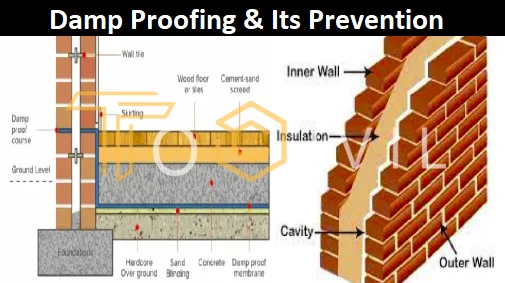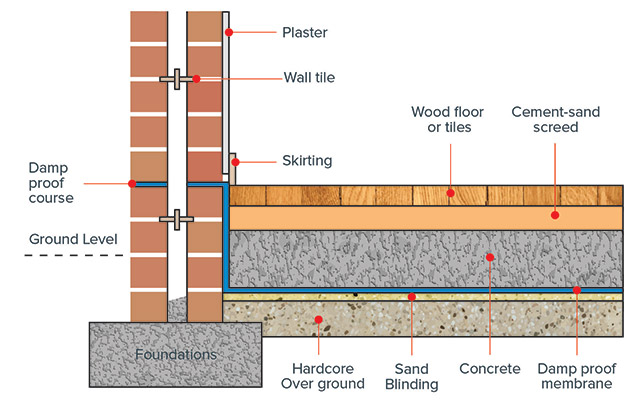Comprehensive list for damp specialist newcastle to identify moisture issues early
Comprehensive list for damp specialist newcastle to identify moisture issues early
Blog Article
Discovering the Various Methods and Solutions for Effective Damp Proofing
Moisture in structures positions substantial challenges to both structural integrity and indoor air quality. Different methods and options have actually arised to battle this prevalent concern. From typical damp-proof membrane layers to cutting-edge chemical therapies, each method uses special benefits. Comprehending these choices is crucial for reliable dampness control. However, selecting the ideal option relies on specific building problems and demands, prompting further exploration into the most efficient moist proofing techniques available.
Understanding the Causes of Wetness
Wetness can occur from various resources, understanding these causes is important for effective remediation. Typically, wetness originates from three main sources: rising moist, penetrating damp, and condensation. Rising wet takes place when groundwater travels upwards with permeable materials, such as block or stone, commonly as a result of a lack of an effective obstacle (mould removal newcastle). Permeating wet is normally brought on by exterior aspects, including roofing system leakages, damaged rain gutters, or harmed walls, permitting water to infiltrate a home. Condensation, on the various other hand, results from excess wetness in the air, usually aggravated by bad ventilation and temperature level differences, bring about water droplets basing on surface areas. Identifying these underlying concerns is important, as each sort of wetness requires a tailored method for removal. Correct assessment helps in establishing one of the most reliable solutions, ultimately safeguarding the structural stability of a structure and boosting interior air quality
Standard Damp-Proof Membrane Layers

Chemical Damp-Proofing Solutions
Chemical damp-proofing remedies offer a cutting-edge method to stop wetness invasion in buildings. These approaches normally involve the application of fluid chemicals that pass through masonry and form a barrier against rising moist. Frequently used chemicals include silanes, siloxanes, and various other water-repellent agents that react with surface materials to produce a hydrophobic layer.The application procedure normally calls for boring openings right into the wall surfaces, injecting the chemical service, and permitting it to treat. This technique is particularly useful for older structures where traditional damp-proof membrane layers might be unwise. Chemical damp-proofing can be much less disruptive and much more affordable than substantial improvement projects.While reliable, these solutions depend on correct application and ecological problems for peak performance. damp removal newcastle. Regular upkeep and tracking are vital to assure the long life of the damp-proofing treatment. Overall, chemical damp-proofing represents a functional alternative for securing structures versus moisture-related damage
Dental Caries Wall Surface Building Techniques
Dental caries wall surface construction methods use countless advantages, particularly in wetness control and power effectiveness. By incorporating an air gap between two layers of masonry, these wall surfaces successfully mitigate water ingress while boosting insulation. This combination not only shields structures from dampness yet also adds to lowered energy usage.
Benefits of Cavity Wall Surfaces
When thinking about reliable wet proofing techniques, the advantages of tooth cavity walls stand apart plainly. Tooth cavity wall surfaces include two different layers, creating an air gap that properly minimizes wetness penetration. This design minimizes the danger of moisture, as the external wall acts as an obstacle versus rainfall and water ingress. In addition, dental caries wall surfaces boost thermal insulation, which contributes to energy effectiveness by lowering warmth loss. They additionally give sound insulation, helping to develop a quieter indoor environment. The air space permits for ventilation, which assists in moisture control and minimizes the possibility of mold development. These benefits not just enhance the general comfort of a building but likewise add to its long life and structural honesty.
Moisture Control Methods
Efficient dampness control methods are essential in tooth cavity wall building to assure lasting security versus wetness. One main technique entails the incorporation of weep holes, which facilitate water drainage from the cavity, avoiding accumulation. Furthermore, making use of breathable membranes can assist manage dampness degrees while permitting trapped vapor to run away. Appropriate positioning of insulation is also critical, as it should not obstruct drainage paths. Furthermore, making sure that the outer leaves of the cavity wall are created with water-resistant materials enhances general durability. Normal maintenance checks are necessary to determine any clogs or damages early, securing the structure's integrity. Ultimately, a mix of these techniques develops a durable protection against wetness invasion in dental caries wall surfaces.
Insulation and Power Efficiency
Insulation plays a vital role in enhancing power effectiveness within cavity wall surface construction. By including shielding products, these walls develop a thermal barrier that lessens warm loss and decreases power intake. Effective insulation not only assists maintain a steady indoor temperature yet likewise mitigates the threat of wetness, as it stops condensation within the wall surface cavity. Various techniques, such as using rigid foam boards or mineral woollen, can be used to attain suitable insulation performance. Furthermore, appropriate setup is necessary to guarantee that spaces and voids are decreased, which can otherwise jeopardize energy efficiency. Inevitably, a well-insulated dental caries wall adds substantially to total sustainability and reduces home heating and cooling prices for house owners.
External Damp Proofing Techniques
Outside damp proofing approaches are important for safeguarding frameworks from moisture infiltration. 2 reliable methods consist of the application of water-proof membrane layers and the installation of French drains pipes. These options assist reduce water build-up and preserve the integrity of buildings.
Waterproof Membrane Layer Application
While various methods exist for avoiding moisture ingress, the application of water-proof membrane layers continues to be an extremely reliable exterior damp proofing strategy. These membrane layers are generally made from materials such as polyethylene, rubber, or changed bitumen, offering a durable barrier against water infiltration. The installation procedure includes using the membrane layer to the external surface areas of structures or wall surfaces, making certain total coverage to protect against leaks. Proper attachment and securing at joints are vital to taking full advantage of effectiveness. Waterproof membranes can be applied in various forms, including liquid coatings and sheet membranes, permitting flexibility based upon the specific requirements of the framework. This technique not only safeguards structures from dampness yet likewise enhances their durability and structural integrity.
French Drainpipe Installment
One efficient technique for taking care of groundwater and stopping moisture build-up around a structure's foundation is the installment of a French drain. This drainage system contains a trench filled with gravel and a perforated pipe that reroutes surface area water away from the structure. Correct setup calls for cautious preparation, guaranteeing that the drain slopes away from the structure to facilitate ideal water circulation. In addition, the area of the drain is important; it ought to be placed in locations prone to pooling or excess moisture. Normal upkeep, including cleaning debris from the gravel and making certain the pipeline continues to be unblocked, is crucial for long-lasting effectiveness. Eventually, a well-installed French drainpipe can considerably decrease the threat of water-related problems in cellars and foundations.
Inside Waterproofing Strategies
Inside waterproofing approaches are important for protecting a structure's interior from dampness seepage and potential water damages. These strategies commonly include the application of customized materials and methods made to create a wetness barrier within the framework. One common technique is making use of water resistant layers or sealants on walls and floorings, which protect against moisture from permeating surfaces.Additionally, setting up indoor drainage systems, such as sump pumps, can properly manage water build-up in cellars and crawl areas. An additional technique entails using vapor barriers, which are mounted to hinder moisture motion from the ground right into living spaces.Moreover, dealing with any fractures or spaces in wall surfaces or structures with ideal sealers assures a detailed protection against water invasion. By implementing these interior waterproofing methods, home proprietors can considerably reduce the risk of mold and mildew growth, structural damages, and other moisture-related issues. Proper execution of these strategies is vital for long-lasting protection and building stability.
Regular Upkeep and Evaluation Practices
Routine maintenance and inspection practices are vital for guaranteeing the long-term performance of moist proofing solutions in any building. Routine checks make it possible for homeowner to determine early indications of wetness intrusion, such as peeling off paint, mold and mildew growth, and mildewy smells. These indicators can signify underlying problems that require prompt attention.Inspections should be conducted at the very least each year, focusing on susceptible areas like cellars, creep areas, and exterior walls. Throughout these evaluations, home owners should take a look at sealants, water drainage systems, and ventilation to validate they work correctly.Additionally, keeping rain gutters and downspouts is crucial, as stopped up systems can result in water buildup near the foundation. Applying a regular upkeep routine, along with prompt repair work, can considerably extend the lifespan of moist proofing steps and shield the structural integrity of the structure. Proactive procedures ultimately add to the general health and wellness of the living setting.
Often Asked Inquiries
Exactly How Lengthy Does Damp Proofing Typically Last?
The duration of wet proofing performance varies, usually lasting in between 20 to 50 years. Aspects such as application top quality, environmental conditions, and upkeep techniques substantially influence the longevity of get more info the damp proofing treatment.

Can I Damp Proof My Home Myself?
The specific considered the feasibility of do it yourself damp proofing. With proper research study and the right products, it is possible. They additionally identified the significance of professional assistance to guarantee durable efficiency and prevent future concerns.
What Are the Indications of Ineffective Damp Proofing?
Indicators of inefficient wet proofing consist of persistent stuffy odors, visible mold development, peeling paint, damp spots on walls, and wood decay - mould treatment newcastle. Property owners need to resolve these concerns quickly to stop more damage and health issues
Does Damp Proofing Affect Indoor Air Quality?

Just How Much Does Professional Damp Proofing Cost?
Specialist damp proofing expenses differ considerably, generally varying from $1,000 to $5,000 relying on the residential property's dimension, the degree of the damp issue, and selected techniques. Each scenario needs a tailored evaluation for precise prices. Commonly, dampness originates from three main sources: increasing damp, penetrating moist, and condensation. When considering efficient wet proofing approaches, the advantages of tooth cavity wall surfaces stand out prominently. External wet proofing methods are necessary for shielding structures from moisture infiltration. While various methods exist for preventing wetness access, the application of water resistant membrane layers remains a very effective outside wet proofing technique. Indicators of ineffective moist proofing include consistent stuffy smells, noticeable mold and mildew development, peeling paint, damp patches on walls, and timber degeneration.
Report this page